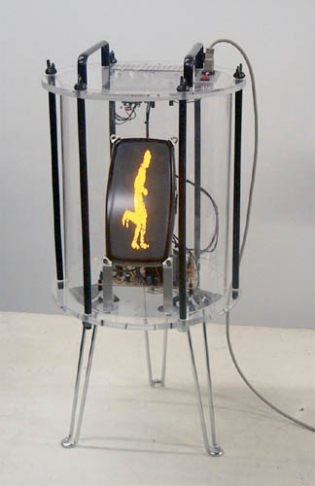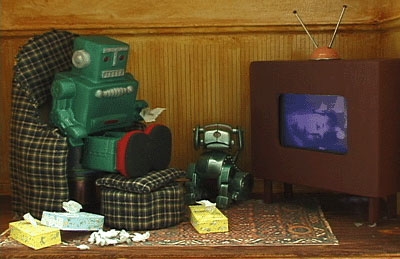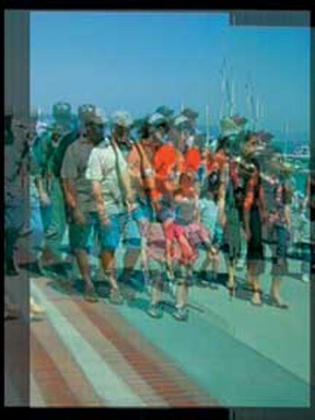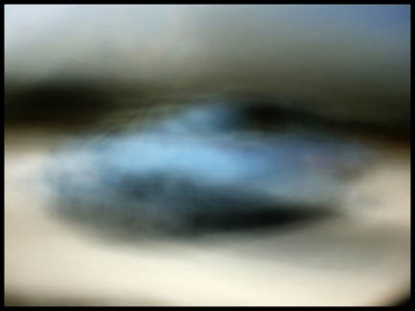Feature: Reviews
High Tech/Low Tech Hybrids: Art in a Digital Age
- Bedford Gallery
- Walnut Creek, California
- March 26 - June 16, 2002
High Tech/Low Tech Hybrids: Art in a Digital Age is a well-orchestrated collection of the vanguard of Bay Area media art stars, and the show is perhaps most interesting in the obviousness of its choices. Like a David Hockney photo collage, the show’s method is so clear and, well, just plain right, that one wonders why it didn’t happen before. And, more importantly, why hasn’t this been done in by a venue right smack dab in the middle of downtown San Francisco? Media has become one of the Bay Area’s main art exports, with media artists breaking into the national and international scene. Shows such as the Whitney Biennial are actually including Bay Area artists, and for the most part it is media work that is making that leap. The staging of the show in Walnut Creek (which for city dwellers is through the tunnel and down the highway a piece) brings up the missing link between emerging artist and national star: venues that support established local artists. Bedford Gallery curator Carrie Lederer consistently fills that gap. OK, so there isn’t much that is emerging and absolutely new, new, new. But then again, I may be a bit more familiar than most, as I have been a media art junkie since Techni showed in 1996, and I have become acquainted with several of the artists.
As with any good curation, it is the collection of works that develops the resonance of the show as a whole, integrating the observations and insights possible from the works into one space. And so it occurs with High Tech/Low Tech. There is a streak of humanity here: a flicker of humor, an abject reminder of the body, a tactile beauty that appeals to the senses and thereby reasserts the humanness of the artist’s intention. Each artist specifically reminds us that there is a man (or woman) behind the magic electronic curtain!
Rueben Lorch-Miller created a work derivative simultaneously of Marcel Duchamp and a Hawaiian-theme restaurant in Cleveland, with his Falls 2001. A large five-foot lightbox photo of an animated waterfall (hence Marcel Duchamp) is set on a path of nine white hardware-store-variety pseudo-rocks, which house the speakers for the accompanying sound piece. Wires snake between the rocks with no intention of concealment. This is artifice with no shame (hence a Hawaiian-theme restaurant in Cleveland). The sound piece as well is intentionally synthetic, a mechanically animated reworking of the high-pitched scratchy hum a computer makes when it is online. Our experience is recreated so that we need never leave the comfort of home.
With Starstruck, Gail Wight provides a doll’s house version of life in the cyborg lane. A bereft robot lounges in his living room set, complete with robo-dog, framed images of robo-relatives, and a video monitor playing Fritz Lang’s Metropolis. Like the replicant in Blade Runner, our couch potato protagonist is capable of emotion, a box of Kleenex clutched to his stomach, used tissues strewn around the feet of his chair. His sobbing, of course, is electronically powered. Is this mourning a sign of his potential for empathy or a sign of the fabricated nature of media catharsis? We become robots in front of the tube.
Ann Chamberlain creates a seductive and tactile expression of the fascination and potential inherent in the scientific mapping of the human genome project. Terra Incognito: Fragments of a Body of Human Knowledge makes the connection between the 16th-century voyages of discovery to the New World and our contemporary submolecular efforts to map out DNA. The inaccurate maps of 16th-century understanding of cities and continents are “remapped” by duplication and rotation, creating Rorschach patterns open to interpretation. The actual letters of the encoding of the human genome project are laser-etched into the delicate surface of the rice paper to form a lacelike pattern edged with a fine brown trace from the burning involved in the process. Suspended by pins from the wall, the series of thirteen maps cast an intricate shadow onto the wall a few inches behind.
Rebeca Bollinger downloaded family portrait images from the AOL archive for Six of 2800 Items, then printed them onto a limited edition of matzo crackers. The literal translation of the feeding and eating of images in a mass media culture is witty and amusing (that flicker in the eye of humanity), but the religious overtones are confusing and seem unintentionally naïve. The physical characteristics of matzo make an intriguing choice, as the brown markings of the cooking wrinkle the surface with their ever-present edibility. But matzo is as central to Jewish food tradition as Manechevitz wine, so an all-American cracker might have raised less conflict.
Jim Campbell condenses the time it takes to watch a movie with Hitchcock’s Psycho, Illuminated Averages Series, 2001. By scanning each frame of Hitchcock’s film, a composite or “average” image is produced that literally translates the film into the realm of two dimensions. The by-product, like residue on the beeker of a strange experiment, reveals a monochromatic charcoal grey that glows like an X-ray print. Locked within the ghostly images of household objects, the lamp and the bird in Norman’s room reveal themselves around the white center with a fog of Vivian Lee’s face as she contemplates her actions while driving to her fate at the Bates Motel.
A plate is set to an infinite rocking, hovering, and wavering on the lip of a kitchen sink, looped to repeat continuously but not seamlessly, on its soon-to-be-shattered edge in the suspended animation of Bob Linder’s video Untitled 2001. We do not for a minute believe this is real-time video, and again the viewer is returned to the art of simulation, which has folded back on itself as the recurrent theme of the show. “This is not a plate; this is a video” proclaims Linder. The magic of the curtain has been pushed aside, and humanity has been revealed.




